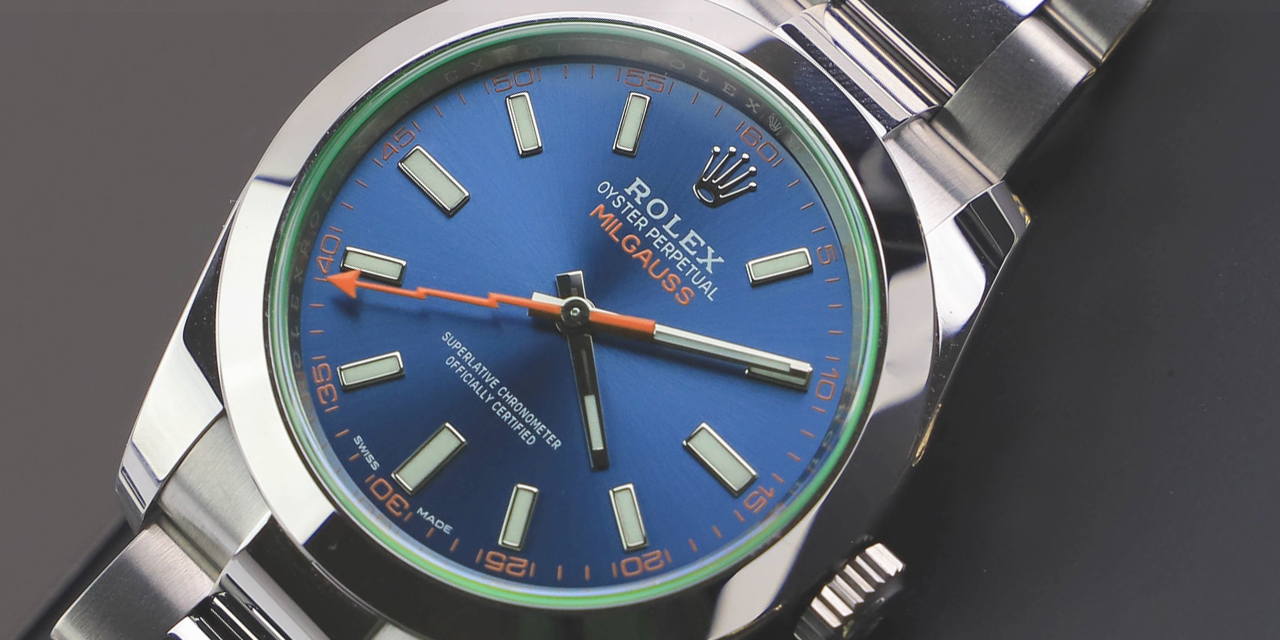The Electrifying Three-Part History of the Rolex Milgauss
Rolex Milgauss History – Three Parts
By the mid-1950s, Rolex had already developed tool watches for adventurers (Explorer), for divers (Submariner), and for pilots (GMT-Master). The company then turned their attention to another community in need of a specific type of watch—scientists. Due to the nature of their work, scientists, engineers, and medical professionals required a watch that could withstand high levels of magnetic forces. Magnetic fields are very detrimental to watch movements and can cause them to become magnetized. A magnetized timepiece will, in fact, speed up, thus rendering it useless as a timekeeping instrument. Rolex’s answer to the dilemma? The Milgauss watch. Read on for a quick three-part Rolex Milgauss history lesson on its anti-magnetism and appeal.
Milgauss History Part I
The name Milgauss is a portmanteau of the French word for 1,000, “mille,” and the unit for measuring magnetism, “gauss”. Therefore, as its name suggests, the Rolex Milgauss can take on 1,000 gauss of magnetic forces with no harm to the movement. This is because of an iron shield protecting the automatic movement within the case. To prove the Migauss’ resistance, Rolex had the watches tested by the European Organization for Nuclear Research (CERN)—the world’s leading particle physics lab.
According to this Rolex Milgauss history, the inaugural Milgauss made its debut in 1956 as the ref. 6543. This was quickly followed by the ref. 6541 that same year. Since only very few examples of the Milgauss ref. 6543 were ever made, it’s an elusive model that shows up rarely in the vintage watch market. The ref. 6541, on the other hand, is a popular vintage Rolex and is often (incorrectly) cited as the original Milgauss.
At first glance, the Milgauss ref. 6541 looks very much like a Submariner of the same era thanks to its steel Oyster case, black rotating bezel with 60-minute markings, and red text on the dial. However, exclusive to the Milgauss is its signature design detail, the lightning bolt seconds hand, emphasizing its connection to the scientific community. Another coveted design touch of the Milgauss is the honeycomb dial housed within its large (for the times) 38mm case. In addition to its attractive style, the honeycomb dial is said to have played a part in beefing up the watches resistance to magnetism on account of the two metal layers of its construction.
Milgauss History Part II
In the 1960s, Rolex replaced the Milgauss ref. 6541 with the updated Milgauss ref. 1091. Surprisingly, many of the design details that made the Milgauss stand out in the first place were no longer there. Gone was the thunderbolt seconds hand in favor of a red-tipped straight seconds hands. Furthermore, the black honeycomb dial made way for a plain black or white dial. Plus, a smooth domed bezel took the place of the original rotating graduated black bezel.
While the ref. 1091 was a very different looking watch to its predecessors, technically it still held up its promise of ultra resistance to magnetic forces. Rolex eventually discontinued the ref. 1091 in 1988. And with that, they laid to rest the Milgauss collection …temporarily.
Milgauss History Part III
Almost two decades after suspending Milgauss production, Rolex Milgauss history shows us that they revived the scientist’s watch with a completely modern iteration. They introduced the Milgauss ref. 116400 at Baselworld 2007.
To keep up with today’s style trends, the modern Milgauss ref. 116400 sports a larger 40mm stainless steel Oyster case, along with a matching steel Oyster bracelet. The first editions of the Milgauss ref. 116400 offered two dial options in black or white. But most importantly, the iconic lightning bolt seconds hand has returned, and in a vibrant orange color no less. Rolex also included a special anniversary edition of the modern Milgauss with the ref. 116400GV where GV stand for “glace verte”, which translates to “green glass”. Hence, protecting the face of the Milgauss ref. 116400GV is a green sapphire crystal that gives a futuristic aura to the watch.
In 2014, Rolex enhanced the collection with the Milgauss ref. 116400GV Z-Blue dial edition. The vibrant blue dial coupled with the ultra modern green crystal come together in one of the most distinct looking Rolex watches to date.
Perhaps the quirkiest member of the Rolex lineup, the Milgauss, illustrates the Swiss watchmaker’s obsessive pursuit to create watches that are both beautiful to wear and practical to use in a range of environments, whether the bottom of the ocean, high-up in the sky, or in the middle of a laboratory.
— Featured Photo Credit: PxFuel (cc).





